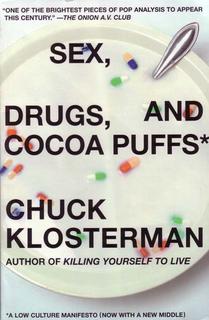TV APPRECIATION: SAVED BY THE BELL
 Extracto de Sex, Drugs, and Cocoa Puffs
Extracto de Sex, Drugs, and Cocoa PuffsSaved by the Bell is like this little generational secret that’s hyperfamiliar to people born between 1970 and 1977, yet generaly unremarkable to anyone born after (and completely alien to all those born before). It was an NBC sitcom that ran for four years (1989 to 1993) ahter an initial thirteen-episode season on the Disney Channel (where it was originally titled Good Morning, Miss Bliss). The show spawned two spin-offs–Saved by the Bell: The College Years and Saved by the Bell: The New Class–and also included a six-episode summer run (usually refered to as the “Malibu Sands” miniseason) and two other made-for-TV movies (one set in Hawaii, the other in Las Vegas).
It was a program about high school kids.
I realize that is not much expository information. Typically, one tries to explain TV shows in terms of “context”–if someone asked me to describe The X-Files, for example, I would seem like a moron if I said, “It was a program about two people who mostly looked for aliens.” That would never qualify as a significant description. I would have to write about how the supernatural religiosity of The X-Files personified a philosophical extension of its audience, and how the characters represented two distinct perspectives on modern reality, and how the sexual chemistry between Mulder and Scully was electrified by their lack of physical intimacy. All this abstract deconstruction is necessary, and it’s necessary because The X-Files was artful. However, I have never watched even one episode of The X-Files, because I’m not interested. I’m not interested in trying to understand culture by understanding that particular show, and that’s part of the social contract with appreciating anything artful. You can’t place something into its aforementioned “context” unless you know where (and how) to culturally file it, and I honestly don’t care where The X-Files belongs in the American zeitgeist. Dozens of smart people told me how great this show was, and I’m sure they were right. But I’m satisfied with assuming that program was about two people who mostly looked for aliens, so –as a consequence- the show meant nothing to me. I “don’t get it.”
That’s not the case with Saved by the Bell. Saved by the Bell wasn’t artful at all. Now, that doesn’t mean it’s bad (nor does it mean it’s good). What it means is that you don’t need to place Saved by the Bell into any context to experience it. I didn’t care about Saved by the Bell any more than I cared about The X-Files, but the difference is that I could watch Saved by the Bell without caring and still have it become a minor part of my life, which is the most transcendent thing any kind of art can accomplish (regardless of its technical merits).
When I first saw Saved by the Bell, I was a senior in high school. It was on Saturday mornings, usually right when I woke up (which I think was either 11:00 or 11:30 a.m.). It was supposedly the first live-action show NBC ever broadcast on a Saturday morning, an idiom that had previously been reserved for animation. I would watch Saved by the Bell the same way all high school kids watch morning television, which is to say I stared at it with the same thoughtless intensity I displayed when watching the dryer. I watched it because it was on TV, which is generally the driving force behind why most people watch any program. However, I became a more serious Saved by the Bell student when I got to college. I suspect this kind of awakening was not uncommon, as universities always spawn little cultures of terrible TV appreciation: When I was a sophomore, the only non-MTV shows anyone seemed to watch were Saved by the Bell, Life Goes On (that was the show about the retarded kid) , Quantum Leap, the Canadian teen drama Fifteen, and Days of Our Lives. And what was interesting was that everybody seemed to watch them together, in the same room (or over the telephone), and with a cultic intensity. We liked the “process” of watching these shows. The idea of these programs being entertaining never seemed central to anything, which remains the most fascinating aspect of all televised art: consumers don’t demand it to be good. It just needs to be watchable.
Chuck Klosterman es también autor de Fargo Rock City y Killing Yourself to Live, comentados en un post anterior.

0 Comentarios:
Publicar un comentario
Suscribirse a Comentarios de la entrada [Atom]
<< Página Principal